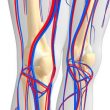Transulnar access can be as safe and effective as transradial access, and it is a particularly good alternative for the preservation of radial artery patency or when such vessel presents a difficult anatomy. This new meta-analysis that will be published soon in Catheter Cardiovasc Interv showed a relatively high failure rate for that access, but<a href="https://solaci.org/en/2018/03/26/transulnar-access-another-ace-up-our-sleeve-before-transfemoral-access/" title="Read more" >...</a>
Silent Diabetes Is the New Stealthy Enemy
One in three “nondiabetic” patients who undergo angioplasty with current drug-eluting stents have an altered glucose metabolism, which is associated with a 4-fold higher risk of events, according to a study that will be published soon in JACC Intv. One in three patients is definitely one patient too many, and four times higher is definitely<a href="https://solaci.org/en/2018/03/20/silent-diabetes-is-the-new-stealthy-enemy/" title="Read more" >...</a>
Complete Revascularization Is Beneficial in Acute MI with Cardiogenic Shock
Around half of all cases of ST-segment elevation acute myocardial infarction (STEMI) come alongside lesions in another vessel, for which the current strategy is complete revascularization in one or two steps. However, there are no large-scale studies analyzing patients who also present cardiogenic shock; we only have observational studies with inconclusive results influenced by several<a href="https://solaci.org/en/2018/03/16/complete-revascularization-is-beneficial-in-acute-mi-with-cardiogenic-shock/" title="Read more" >...</a>
What Is the Prognosis for Reinterventions in Critical Lower Limb Ischemia?
Infrapopliteal (below the knee, BTK) percutaneous transluminal angioplasty (PTA) has been acknowledged as a useful strategy in chronic critical limb ischemia (CLI), but artery calcification severity results in considerable restenosis. Repeat PTA and the management of trophic lesions help with wound healing. However, this conduct has not been extensively assessed. This study enrolled 152 patients (175 limbs)<a href="https://solaci.org/en/2018/03/14/what-is-the-prognosis-for-reinterventions-in-critical-lower-limb-ischemia/" title="Read more" >...</a>
Lesion Targeting Seems to Be the Secret in Critical Ischemia
Ulcers that do not heal, thus threatening the integrity of a lower limb in patients with critical ischemia, is a main concern. Sometimes, despite successful revascularization, major amputation cannot be prevented. The anatomical description of angiosomes started in the 70s as a way of optimizing tissue grafts. Angiosomes are basically blocks of tissue that include<a href="https://solaci.org/en/2018/03/08/lesion-targeting-seems-to-be-the-secret-in-critical-ischemia/" title="Read more" >...</a>
These were the 5 most read scientific articles of February
1) The CULPRIT-SHOCK Study Is Finally Published in NEJM and It Is Bound to Change Guidelines During SOLACI’s coverage of the TCT 2017 Congress in Denver, Colorado, we already mentioned some of the outcomes of this study that has arrived to revolutionize clinical practice, given the differences between its results and those of the classic SHOCK trial, which has marked<a href="https://solaci.org/en/2018/03/01/these-were-the-5-most-read-scientific-articles-of-february/" title="Read more" >...</a>
Surprising Prognosis for Normal ACS
St elevation acute coronary syndromes are typically caused by thrombotic obstruction of a coronary artery due to ruptured atherosclerosis plaque. However, there is a significant number of patients with similar clinical presentations but no evidence of obstructive coronary artery disease (CAD). Read also: CTO in patients with acute myocardial infarction increases long term mortality. In general, patients without<a href="https://solaci.org/en/2018/03/01/surprising-prognosis-for-normal-acs/" title="Read more" >...</a>
Pharmacological balloons in femoropopliteal territory passed time testing
Endovascular revascularization has become the main strategy for symptomatic patients with peripheral arterial disease in femoropopliteal territory. Conventional balloon angioplasty is effective in gaining lumen but has a restenosis rate to up 60% at 12 months. Implantation of conventional stents reduced restenosis to almost half, but presented problems such as thrombosis, stent fracture and difficulty<a href="https://solaci.org/en/2018/02/27/pharmacological-balloons-in-femoropopliteal-territory-passed-time-testing/" title="Read more" >...</a>
Coronary Disease Works as a 30-Day Predictor in TAVR
The association between aortic stenosis and coronary disease is common, since both conditions share pathogenesis, risk factors, and symptoms. Transcatheter aortic valve replacement (TAVR) is currently indicated for high-risk and inoperable patients. It also appears as a valid alternative for the treatment of intermediate-risk patients, and it could soon be indicated for low-risk patients. Coronary<a href="https://solaci.org/en/2018/02/20/coronary-disease-works-as-a-30-day-predictor-in-tavr/" title="Read more" >...</a>
Who Lives Longer After TAVR, Men or Women?
Courtesy of Dr. Carlos Fava. Currently, some small observational studies and a meta-analysis suggest that women experience more short-term complications after TAVR (due to higher rates of bleeding, vascular complications, and stroke), as well as less 1-year mortality. However, results are still conflicting. This work analyzed 17 studies including 8 different registries, with a total 23,303 women and 23,885 men.<a href="https://solaci.org/en/2018/02/14/who-lives-longer-after-tavr-men-or-women/" title="Read more" >...</a>









